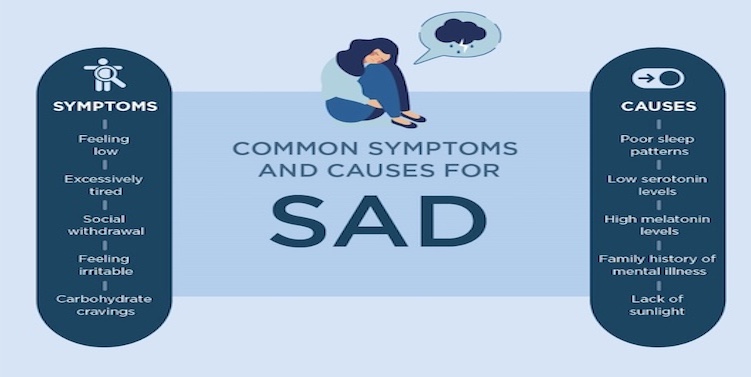
Written by Jennifer Cox LCPC
Seasonal affective disorder (SAD) is a recurrent major depressive disorder with a seasonal pattern usually beginning in fall and continuing into the winter months. However, SAD does occur in the spring/early summer for some, but that isn’t the predominant pattern. Overall, this mood disorder affects an estimated 10 to 20 percent of the population.
For the majority that experience in the fall/winter, the shorter daylight hours leave many people with little to no sun exposure, signaling the brain to create too much of the sleep-regulating hormone melatonin. This overproduction of melatonin is one of the causes of SAD.
Also, another area that is associated with SAD comes from the difficulty of regulating the neurotransmitter serotonin, a neurotransmitter believed to be responsible for balancing mood.
The combination of decreased serotonin and increased melatonin impacts our circadian rhythms, our body’s internal 24-hour clock.
Without the proper signaling from the body’s internal clock, one can experience the following symptoms:
-Anxiety
-Irritability
-Feeling sad
-Loss of interest
-Lack of motivation
-Social isolation
-Excess sleepiness
-Lack of energy
-Appetite changes – craving carbs and sugars
-Weight gain
-Having difficulty concentrating
What can you do:
-Light therapy – Full spectrum light regulates hormones in the brain and helps keep your mood stabilized.
-Get outside, especially on sunny days for 15-20 minutes. It helps to regulate your internal clock.
-Adjust your hobbies to fit the season.
-Practice wellness – A daily routine of at least 7 hours of sleep and a 30 minute exercise routine.
-Take Vitamin D – Vitamin D is believed to play a role in serotonin activity.
-Consider your diet
-Psychotherapy – Cognitive behavioral therapy can help you:
- Learn healthy ways to cope, especially with reducing avoidance behavior and scheduling meaningful activities
- Identify and change negative thoughts and behaviors that may be making you feel worse
- Learn how to manage stress
- Build in healthy behaviors, such as increasing physical activity and improving your sleep patterns
https://www.ncbi.nlm.nih.gov/pmc/articles/PMC4673349/#!po=1.02041

